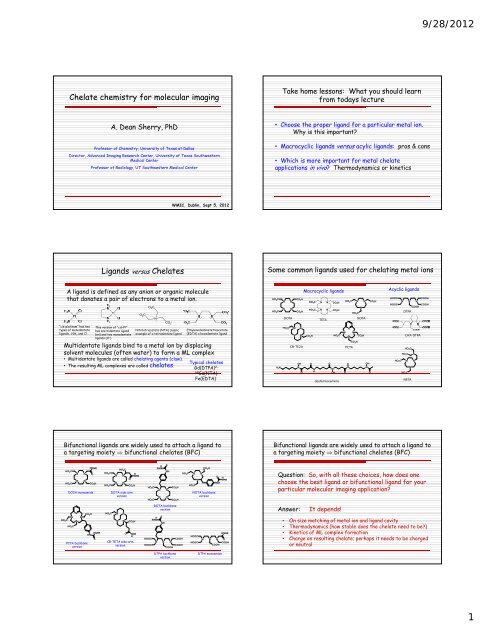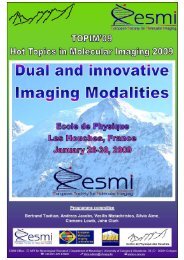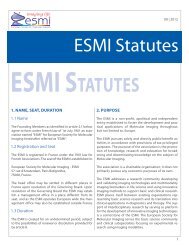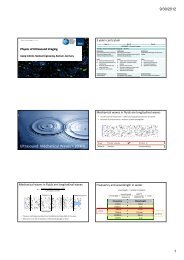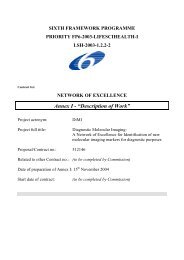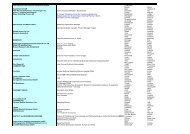Chelate chemistry for molecular imaging Ligands versus Chelates
Chelate chemistry for molecular imaging Ligands versus Chelates
Chelate chemistry for molecular imaging Ligands versus Chelates
You also want an ePaper? Increase the reach of your titles
YUMPU automatically turns print PDFs into web optimized ePapers that Google loves.
9/28/2012Some common radionuclides and ligandsused in <strong>molecular</strong> <strong>imaging</strong>Factors to consider in the design ofligands <strong>for</strong> various metal ionsImagingModalityMostcommonmetal ionMost common ligand(s)Ligandcharacteristics(coord #, donor types)MRI Gd 3+ DOTA-like, DTPA-like 8-coordinate, needsone water site, prefers“hard” donor atomsPET 64 Cu 2+ cyclen, DOTA, TETA,bridged TETA, NOTAPrefers N donors, only4 coordinate necessary68 Ga 3+ DOTA, NOTA Prefers octahedral and“hard” donor atoms86 Y 3+ DOTA-like 8-9 coordinate likeGd 3+89 Zr 2+ Desferrioxamine-like “hard” oxygen donorsSPECT 99m Tc2+ Methoxyisobutylisonitrile(Sestamibi)N donor atoms111 In 3+ DTPA-like 8-coordinate,somewhat “softer” ion• Selection of ligand donor atoms• HSAB principles, matching coordination numbers• Role of ligand architecture (cyclic <strong>versus</strong> acyclic)• Limited to size-match selectivity• Kinetics of ML complex <strong>for</strong>mation & dissociation• <strong>Ligands</strong> with flexible backbone structures <strong>for</strong>mcomplexes more quickly but also dissociate faster• Macrocyclic ligands <strong>for</strong>m complexes more slowly but alsodissociate more slowlyHard-Soft Acid-Base Principles (HSAB)Ligand donor types (from softest to hardest): P < S < N < O < FSize does matter!For 3d transition metal ions 21Sc22Ti23V24Cr25Mn26Fe27Co28Ni29Cu30Zn1) M 2+ ions get smaller and harder from left to right (increasing nuclear charge)Ti 2+ (86 pm) > V 2+ (79 pm) > Cr 2+ (73 pm) > Mn 2+ (67 pm) > Fe 2+ (61 pm)2) M + (softer) < M 2+ (intermediate) < M 3+ (harder)HO 2CHO 2CN NN NDOTACO 2HCO 2HHO 2C N NNHO 2CNOTACO 2HV 2+ (79 pm) >> V 3+ (64 pm) >> V 4+ (53 pm)As one progresses down a series (3d 4d 5d) <strong>for</strong> ions of the same charge222530Ti hardest Mn hardest Zn hardestGd 3+ (4f 7 ) ionic radius ~1.0Å log K st = 24.7 a log K st = 14.3 aGa 3+ (3d 10 ) ionic radius ~0.6Å log K st = 21 b , 26 c log K st = 31 b40Zrintermed.43Tcintermed.48Cdintermed.a WP Cacheris, SK Nickle & AD Sherry, Inorg Chem, 26, 958-960 (1987)b Clark & Martell, Inorg. Chimica Acta, 181, 273-280 (1991)72Hfsoftest75Resoftest80Hgsoftestc Kubicek, et al., Inorg. Chem., 49, 10960-10969 (2010)Some basic definitions: thermodynamic constants,kinetic constants, pKa’s and basicityThermodynamic Stability Constant Determinations:Potentiometry is considered the“gold standard”K STLn 3+ + HL[ LnL]3[ Ln ] [L]Thermodynamic MLstability constantk f,HLk d,HLLnL + H +K cond = conditional stability constant (defined by conditions, i.e., pH)K HL[ L][H ][ HL]Highest pK a of the ligand(most basic site)the reverse rxn is referred to as the firstprotonation step or constant1210080Y 3+Y 3+ L10.560p-NO2-Bz-DOTA409typical curve <strong>for</strong> fastML <strong>for</strong>mation20M 2+ : p-NO 2-Bz-DOTA7.50(log K pH1.5 2 2.5ML=23.5)pH64.53Y 3+ : slow kinetics(log K ML=23.9)1.50 2 4 6 8 10Base equivalentsFraction of Y 3+ species2
9/28/2012--O 2CCO 2N NN N--O 2C CO 2Ligand charge also plays a role-O 2CCO 2--O 2CN N NCO 2-CO 2-- O 2CNNCO 2-- O 2CNNOCNHCH 2CH 2CH 3- O 2CNCO -2CO -2N-2 O 3PNNPO 3-2-O 2C-O 2CNNCO 2-CO 2-- O 2 CNNDOTACO 2-- O 2CNNCO 2-DO3A-NpropylamideN N- O CO -2 C2DO3A-SAN N-2 O 3 PDOTPPO 3-2-O 2CNNCO 2-log K st (Gd 3+ ) 24.7 a 20.1 b 27.2 c 28.8 dNa WP Cacheris, SK Nickle & AD Sherry, Inorg Chem, 26, 958-960 (1987)b AD Sherry, RD Brown, CFGC Geraldes, SH Koenig, K-T Kuan & M Spiller, Inorg Chem., 28, 620-622 (1989)c JP Andre, E Brucher, R Kiraly, RA Carvalho, H Maecke, CFGC Geraldes, Helv. Chim. Acta, 88, 633 (2005).-O 2Cd AD Sherry, J Ren, J. Huskens, E Brucher, E. Toth, et al. Inorg. Chem. 1996,35, 4604 (1996)WP Cacheris, SK Nickle & AD Sherry, InorgChem, 26, 958-960 (1987)Correlation of k f,HL , k d,H , and log K ML with the firstprotonation constant of the ligand (log K HL )log K ST vs ΣpK a ’s <strong>for</strong> a series of GdL complexesLn 3+ + HLk f,HLk d,HLLnL + H +[ LnL][H ] kKeq3[ Ln ] [HL]kf , HLd , H KST KHLlog K STKSTkkd , Hf , HL KHLlog KSTkkf , HLd , H pKaFrom: WP Cacheris, SK Nickle & AD Sherry, Inorg Chem, 26, 958-960 (1987)A more recent compilation: Brücher, et al., “Stability and Toxicity of ContastAgents”, Chapter 5, in The Chemistry of Contrast Agents in Medical MagneticResonance Imaging, edited by Merbach, Toth & Helm, Wiley, 2012.Importance of kinetics:rates of ML <strong>for</strong>mationlog K Gd(L)30262218DOTA-SADO3AP DOTPDOA3PDO3AP PrADOTADO2A2PDO3MAp-NO 2-Bz-DOTADO3AP ABnDO3A-PicHP-DO3A2HE-DO2A2HP-DO2ADO3A-nBuAmDO3APCTADO2Ap-NO 2-Bz-PCTATRITABT-DO3ALn 3+ + HLk f,HLk d,HLLnL + H +Why do macrocyclic ligands <strong>for</strong>m complexes with metal ions so slowly?BP2APC2A DOTEP14 DOTAMDTMANOTADOTA-4Gly1015 17 19 21 23 25Ln 3+ aqfastslow, requiresdeprotonationlog K 1 H + log K 2HH 2 DOTA (pre-organized)Intermediate LnH 2 DOTAFully <strong>for</strong>med LnDOTA3
9/28/2012Correlation of k f,HL with the first protonationconstant of the ligand (log K HL )Comparison of bifunctional chelates <strong>for</strong> 64 Cu 2+ -antibody <strong>imaging</strong>CL Ferreira, DTTT Yapp, S Crisp, et al., Eur J Nucl Med Mol Imaging 37: 2117-2126 (2010)log kf,HL9876HP-DO3AHE-DO3ADO3AHIP-DO3ADOTACuDOTA only moderately stable in vivo; CuNOTA and Cu-CB-TETA more stable but they also <strong>for</strong>mcomplexes too slowly <strong>for</strong> efficient antibody labelingThe three bifunctional ligands were conjugated to trastuzumabThe oxo and pcta derivatives<strong>for</strong>m complexes with 64 Cu 2+much more quickly than dotaoxo & pcta, 0.5 mgdota, 0.5 mgoxo, 0.1 mgpcta, 0.1 mgdota, 0.1 mg512-membered ring, acetate systemsDO3MA410,5 11 11,5 12 12,5 13 13,5pK alog KHLK. Kumar and M. F. Tweedle, Inorg. Chem., 1993, 32, 4193-4199Transverse PET images at 24 h (top) and 40 h (bottom) post-injection <strong>for</strong> each 64 CuradiolabeledBFC-trastuzumab conjugate in LCC6 Vector or LCC6 HER2 tumor-bearing mice.Increased backbone rigidity improves thekinetic stability of complexesAre LnDOTA-tetraamidecomplexes safe <strong>for</strong> in vivo use?Gd(AZEP-DTPA)Gd(PIP-DTPA)AZEP-DTPAGd(DTPA)PIP-DTPAH-S Chong, K Garmestani, LH Bryant, Jr., MW Brechbiel, J Org Chem, 66, 7745-7750 (2001)Take home lessons:• Why it is important to choose the proper ligand <strong>for</strong> a particularmetal ion <strong>for</strong> <strong>molecular</strong> <strong>imaging</strong>.• Ligand size and donor type should match the characteristicsof the metal ion• Macrocyclic ligands <strong>versus</strong> acylic ligands:• Macrocyclic ligands <strong>for</strong>m more stable ML chelates but theyalso <strong>for</strong>m more slowly (this kinetic barrier may be important inradiolabeling of antibodies which cannot be heated)• Which is more important <strong>for</strong> metal chelate applications in vivo?• Thermodynamics is important but kinetics is likely evenmore important <strong>for</strong> in vivo applications!Thanks• To my many students, postdocs & collaboratorsProf. Zoltan Kovacs, Prof. Mark Woods, Bill Cacheris, Garry Kiefer,Prof. Gyula Tirsco, Won-dae Kim, Prof. Jimen Ren, Prof. IstvanLazar, Shanrong Zhang, Prof. Carlos Geraldes, Prof. JurriaanHuskens, Flavio Chavez, Prof. Navin Bansal, Yunkou Wu and,especially, Prof. Erno Brücher (Hungary) who taught me how to dopotentiometry well.• Acknowledgements: Financial support from NIH grants RR-02584,CA-115531, CA-126608, EB-004582 and the Robert A. WelchFoundation (AT-584).4


